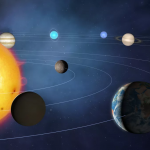Brand-new mini ‘moon’ found lurking in the outer solar system0
- From Around the Web, Space
- September 19, 2022
The tiny natural satellite was found orbiting an asteroid.

The tiny natural satellite was found orbiting an asteroid.

To date, a total of 4,884 extrasolar planets have been confirmed in 3,659 systems, with another 8,414 additional candidates awaiting confirmation. In the course of studying these new worlds, astronomers have noted something very interesting about the “rocky” planets. Since Earth is rocky and the only known planet where life can exist, astronomers are naturally curious about this particular type of planet. Interestingly, most of the rocky planets discovered so far have been many times the size and mass of Earth.

The Solar System floats in the middle of a peculiarly empty region of space.

It’s weirder than you may have imagined.

Scientists have spotted water in a primitive meteorite, expanding our understanding of the ancient solar system.

Data obtained by bouncing radio waves off Venus – treating it, as one scientist said, like a giant disco ball – is providing new insight into Earth’s closest planetary neighbor, including a precise calculation of the duration of a Venusian day.

That glow you see at sunrise or sunset is caused by cosmic dust. For decades astronomers thought it came from asteroids but now they’re not so sure

Researchers have discovered a new superhighway network to travel through the Solar System much faster than was previously possible. Such routes can drive comets and asteroids near Jupiter to Neptune’s distance in under a decade and to 100 astronomical units in less than a century. They could be used to send spacecraft to the far reaches of our planetary system relatively fast, and to monitor and understand near-Earth objects that might collide with our planet.

An international team of astronomers from Serbia and the United States has discovered a new superhighway network to travel through our Solar System much faster than was previously possible.

A fleet of missions is spreading across the Solar System to investigate our neighbours for signs of life. Here’s what they are looking for.